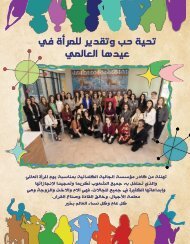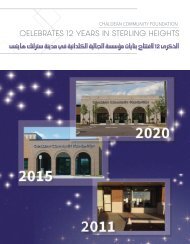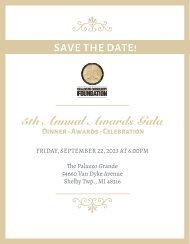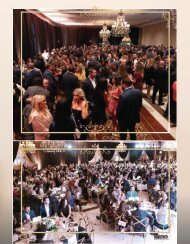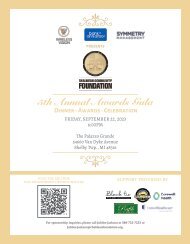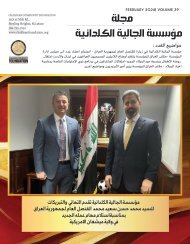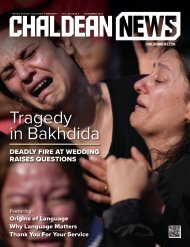Create successful ePaper yourself
Turn your PDF publications into a flip-book with our unique Google optimized e-Paper software.
FEATURE<br />
An Annual Pilgrimage<br />
Our Lady of Consolation draws loyal followers<br />
BY WEAM NAMOU<br />
For nearly half a century, Chaldeans<br />
have been visiting the<br />
Basilica and National Shrine of<br />
Our Lady of Consolation in Carey, Ohio.<br />
It is the site of an annual pilgrimage of<br />
Roman Catholics, primarily Iraqi Christians,<br />
to mark the Feast of the Assumption<br />
of Mary, celebrated August 14, on<br />
the Eve of the Assumption.<br />
On that day, several buses drop off<br />
pilgrims near the information center.<br />
Hundreds of families fill a five-acre<br />
plot with tents, recreational vehicles,<br />
Middle Eastern food, music, and dancing.<br />
Some families camp in the area for<br />
days, others spend the night at nearby<br />
hotels, and many drive to the site for<br />
only a day.<br />
Approximately 5,000 visitors come<br />
every year. This year, the streets were<br />
a little quieter than usual due to the<br />
ongoing rain. Families huddled inside<br />
canopy tents or beneath canopied<br />
buildings. Campgrounds were<br />
filled with large mud puddles. Yet the<br />
weather did not prevent campers from<br />
barbecuing or gathering around campfires.<br />
The townspeople were also out<br />
and about. A mother and daughter sat<br />
on their porch passing out free bottled<br />
water and cookies.<br />
Mass was held at various hours.<br />
Chaldean Masses were held at 12:30pm<br />
with Father Stephen Kallabat and<br />
at 5pm with Father Sameem Balius.<br />
At 9pm the Vigil Mass was celebrated<br />
with a candlelight procession to<br />
Shrine Park.<br />
For over 150 years, the church has<br />
been a place of special importance,<br />
providing peace, warmth, and a consoling<br />
presence for believers. Yet few<br />
are aware of its history. Construction<br />
for the church—the first church in<br />
Carey—began in 1868. It was founded<br />
by people of Luxembourger heritage<br />
under the inspiration of an immigrant<br />
priest from the homeland. Luxembourg<br />
is one of the smallest countries<br />
in Europe and its people had for centuries<br />
fostered a deep devotion to the<br />
Mother of God.<br />
While Father Aloys Fish was the<br />
first Conventual Franciscan to serve at<br />
the shrine, Father Joseph Peter Golden<br />
is considered the shrine’s “father.” He<br />
refused any salary from the congregation<br />
until the church building was<br />
finished. He and the people of Carey<br />
did all the work themselves, save plastering<br />
the wall. Once the church was<br />
completed, he encouraged the congregation<br />
in Carey to direct their prayers<br />
to Mary, the Mother of God, under the<br />
title of Our Lady of Consolation.<br />
Father Golden later arranged for<br />
a statue to be made in Luxembourg,<br />
requesting that it would be as close<br />
a replica of the ancient image in the<br />
Cathedral as possible. At the end of<br />
March 1875, community member Nicholas<br />
Warnament brought this statue<br />
from Luxembourg to Carey; it was<br />
made of oak and could be dressed.<br />
Overjoyed, the parish asked Father<br />
Golden if they could carry the statue<br />
in procession from Frenchtown to the<br />
church in Carey.<br />
Father Golden hesitated for some<br />
time. He feared a public expression<br />
might offend and anger the rather large<br />
Protestant population of Carey. He consulted<br />
several priests in nearby parishes,<br />
and they encouraged him to have<br />
the procession. So, he went ahead.<br />
On May 24, 1875, the statue was<br />
carried in procession from the Church<br />
of St. Nicholas to the church in Carey.<br />
As the procession marched, a severe<br />
storm raged in the entire area. The<br />
story is that although people could see<br />
the rain pouring down on all sides of<br />
them for the entire seven-mile walk,<br />
not a drop touched the statue of Our<br />
Lady of Consolation, nor was anyone<br />
in the procession rained on. This was<br />
considered the first sign of an intercession<br />
of the Blessed Virgin for all<br />
who would come to pray in this little<br />
church.<br />
The procession later moved to the<br />
Shrine Park altar where, in 1956, a 12-<br />
foot, 2-ton bronze statue of Our Lady of<br />
Consolation was placed on top of the<br />
dome of the altar, some 45 feet above<br />
the ground. The statue was made in<br />
Milan, Italy.<br />
What began as an act of faith of<br />
an immigrant community connecting<br />
with their homeland has grown into<br />
a place where people of many ethnic<br />
and cultural backgrounds have come<br />
for pilgrimage. In Father Aloys Fish’s<br />
time, shrine manuals and devotional<br />
materials were printed in Hungarian,<br />
Polish, Slovak, Slovenian, and Italian.<br />
The Lebanese presence and the great<br />
crowds of Chaldean pilgrims have added<br />
their own traditions and cultural<br />
richness to the devotional life of the<br />
shrine over the years. So have Filipino,<br />
Hispanic, Albanian, Vietnamese, and<br />
African American pilgrims.<br />
“This is my first year at the shrine<br />
and the first time I’ve interacted with<br />
Chaldeans,” said Friar Maximilian.<br />
“The only thing I knew about them before<br />
is that their liturgy is in Aramaic.<br />
I’ve had a good experience interacting<br />
with them. They are a kind and faithfilled<br />
people.”<br />
The shrine complex includes the<br />
basilica, the original 1875 wooden parish<br />
church, the parish school, a rectory<br />
housing the pastor and other<br />
Franciscan priests, a provincial house<br />
which houses Franciscan friars, a convent<br />
for resident and visiting nuns,<br />
a retreat center providing lodgings<br />
for lay and religious pilgrims, a gift<br />
shop, and a cafeteria.<br />
Friar Steven, who has served for<br />
some 40 years, was first introduced<br />
to Chaldeans when they started coming<br />
on pilgrimages. He learned more<br />
about them over the years, especially<br />
by interacting with one Chaldean family<br />
who became friends. They bought a<br />
house around the corner of the church<br />
where every year, the half-dozen siblings<br />
come for two weeks.<br />
Friar Steven often goes into the<br />
camps and talks to people. “Sometimes<br />
there’s a language barrier,” he<br />
said, “but I honor their special relationship<br />
to this place which I myself<br />
have.”<br />
28 CHALDEAN NEWS <strong>SEPTEMBER</strong> <strong>2023</strong>




